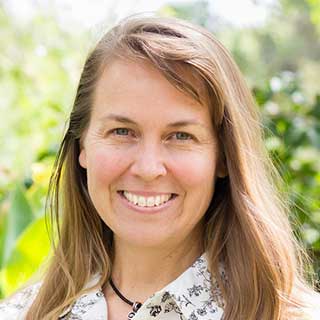Module 3:
The stimulus response model and signal transduction.
The third module within the sequence focuses on developing an understanding of the stimulus response model in the context of metastatic breast cancer to include reception, transduction and a response.
Summary
VCE Biology (2017-2021)
Unit 3, Area of Study 2, Outcome 2, VCE Biology Study Design
Key knowledge
- Cellular signals
- the stimulus-response model when applied to the cell in terms of signal transduction as a three-step process involving reception, transduction and cellular response
- difference in signal transduction for hydrophilic and hydrophobic signals in terms of the position of receptors and initiation of transduction
- Immunity
- the use of monoclonal antibodies in treating cancer
With a focus on:
- Ligand-receptor binding, the signal transduction component process, and how a cell responds using effector proteins.
Duration

Student learning outcomes
Upon completion of this module students will be able to:
- Understand that signalling molecules induce cellular changes and responses in cells
- Be able to transfer and apply their knowledge of this stimulus response model in terms of signal transduction as a three-step process involving reception, transduction and cellular response
Teacher background information
Module description
To understand the signal transduction model in the context of metastasis cancer the students role-play the stimulus-response model and epithelial-mesenchyme transition using the molecules measured in an experiment Ackland et al (2003) conducted.
Resources
Video
Nimotuzumab: Proposed Mechanism of Action (1:52)
This animation demonstrates the blocking of a receptor by Nimotuzumab so that signal transduction cannot occur and can help students visualize the process.
Video
VEGF and EGFR pathways in detail: Target for new therapies against cancer (4:30)
This is an animation that shows the target for new therapies against cancer. A lot of the terms used have not been covered but it can again help students visualize the process.
Research paper
Epidermal growth factor-induced epithelio-mesenchymal transition in human breast carcinoma cells.
Ackland, M.L., Newgreen, D.F., Fridman, M., Waltham, M.C., Arvanitis, A., Minichiello, J., Price, J.T. and Thompson, E.W., 2003. Epidermal growth factor-induced epithelio-mesenchymal transition in human breast carcinoma cells. Laboratory investigation, 83(3), pp.435-448.
Teaching sequence
Activities
[Explaining]
Activity 3.1 - How does a signal transduction inhibitor or a monoclonal antibody work? (20-30 minutes)
To answer the question above the students must first understand the stimulus response model. This is an extension of the role-play representing an epithelial and mesenchyme transition. It includes a cellular response as part of the process and a change in the number of component parts measured in the study by Ackland et al. (2003). The teacher explains the results of the research with the use of the photos of stained cells in Figure 2 p.437. These can be used to see the change in vimentin concentrations in relation to: A. No EGF – control, B. EGF, C. EGF and EGFR inhibitor. Figure 2, D and E show keratin and vimentin staining before and after EGF induction. Students are then shown the videos that elucidate the drugs in action.
The results of the research were:
- An increase in vimentin (A part of the cytoskeleton – an intermediate filament)
- A decrease in E-cadherin (A stronger cell-cell adhesive protein)
- An increase of N-Cadherin (A weaker cell-cell adhesive molecule)
- An increase in motility
Cellular Communication Role-play Activity
In this activity, the Classroom Cell Communication activity (MSWord 138KB) provided by MIT is adapted to become context specific: involving some of the key molecular changes in the epithelial-metastatic transition in the mammary gland of a human breast. The teachers and students organize the desks in the classroom so that there is a cellular membrane, nuclear membrane and students act as component parts.
Teacher prompts:
- What protects a cell and regulates a cells internal environment? Cell membrane
- Where is the nucleus? Away from the cell membrane, polarized.
Other questions can be asked for students to apply previous information, i.e.
- What receives a message in the nucleus? Transcription factor
- Where are proteins made?
The teacher uses a diagram to model the process with the students. When set up the teacher provides the ligand in the form of a written message, ‘turn into a mesenchyme cell’ and the students roleplay the process of transduction and cellular response. The teacher or a student creates a message requesting ‘goods or services’ for the cell to produce or carry out, i.e. change into a mesenchyme cell.
The message (ligand) – e.g. “change into a mesenchymal cell” is received outside of the cell by the student sitting on the desk (the cell membrane) before being passed on by other students (proteins) until it is received by the students in the nucleus (transcription factor, DNA, RNA (transcription)) who goes to the student outside the nucleus (a ribosome (translation)) to create protein effector molecules and asks them to carry out a function, to carry out the function of changing into a mesenchymal cell.
Exam style written response
[Formative Assessment]
After the roleplay the students are presented with an exam style question: Draw an annotated diagram to show the stimulus response model in terms of signal transduction explaining how the attachment of a molecule such as epithelial growth factor brings about a response within the cell to make it change into a mesenchymal cell.
Next module: Signalling Molecules
 Contemporary VCE Biology
Contemporary VCE Biology


